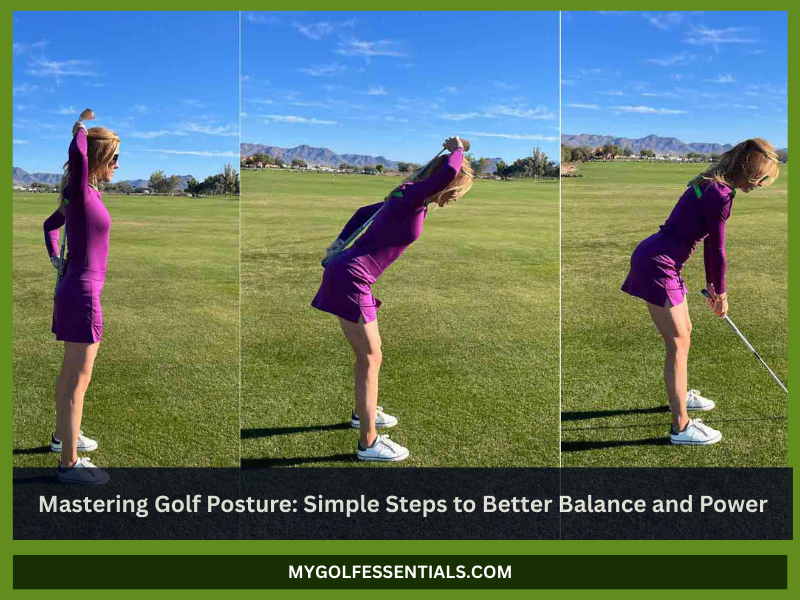
If you’re looking to hit the ball more consistently and with greater power, improving your golf posture is a great place to start. The way you position your body before the swing affects everything, your balance, alignment, and ability to generate clubhead speed. Many golfers overlook posture, but it’s the foundation of a solid, repeatable swing that holds up under pressure.
In this guide, we’ll walk you through simple, effective steps to master your posture, from your stance and setup to shoulder alignment and weight distribution. Whether you’re a beginner or looking to fine-tune your fundamentals, these techniques will help you play with more confidence and control.
Understanding the Fundamentals of Golf Posture
Golf posture refers to the way you position your body at address, before you ever swing the club. It’s the foundation for everything that follows in your swing. A correct posture for golf keeps your spine neutral, your weight balanced, and your muscles relaxed but engaged. It sets the stage for a smooth takeaway, controlled rotation, and solid contact.
Proper golf posture directly impacts your swing mechanics and shot accuracy. With the right body position, you allow the club to move on the correct path, which leads to more consistent ball striking. It also enables better golf alignment and helps generate power efficiently, using your body’s natural mechanics rather than forcing the motion.
A solid golf setup position gives you a repeatable swing and helps prevent injuries. When your spine, hips, knees, and shoulders are correctly aligned, your body moves more fluidly, reducing strain and promoting long-term performance.
Common Posture Mistakes
Many golfers, especially beginners, fall into common posture traps that can ruin an otherwise solid swing.
Here are frequent mistakes to avoid if you want to oerfect your golf posture:
- Slouching the shoulders: This rounds the upper back and restricts rotation.
- Over-bending from the waist: Leads to a hunched position and poor balance.
- Straight or locked knees: Reduces athleticism and limits lower body engagement.
- Too upright a stance: Causes inconsistency and poor club path.
- Tension in arms and grip: Makes the swing rigid and jerky.
Poor posture not only hurts your ball-striking but also reduces your ability to create power. You may struggle with slicing the ball, hitting it fat or thin, or losing control of distance. Fortunately, with awareness and practice, these posture issues are easy to fix.
Building the Proper Golf Setup
The proper golf setup is a critical piece of the puzzle when trying to improve golf posture and performance. Think of it as your launchpad, the more stable and balanced you are at address, the better your chances of executing a solid swing.
Feet Positioning
Your feet form the base of your golf stance, so how you place them matters. A good rule of thumb is to position your feet about shoulder-width apart. This width offers stability without restricting movement.
Adjust the stance width based on the club you’re using:
- Short irons and wedges: Slightly narrower stance.
- Mid to long irons: Standard shoulder-width stance.
- Driver or fairway woods: Slightly wider stance for more balance and power.
Knee Flex and Weight Distribution
Maintaining a slight knee bend keeps your legs athletic and ready to move. Locked knees make it harder to initiate a powerful downswing and lead to stiffness in your swing.
Balance your weight:
- Distribute your weight evenly between both feet.
- Keep weight centered over the balls of your feet, not the heels or toes.
- For longer clubs or a draw/fade, slightly adjust weight toward the lead or trail foot.
Hip Hinge and Spine Angle
One of the most overlooked elements of a strong golf setup position is the hip hinge. Instead of bending from your waist, tilt from your hips to lower your upper body. This keeps your back flat and spine neutral, an essential aspect of proper golf body position.
When you hinge from the hips:
- Your chest points downward naturally.
- Your arms hang freely under your shoulders.
- Your spine angle remains consistent throughout the swing.
This “athletic posture” gives you the best chance to rotate properly, stay balanced, and produce a smooth, powerful swing. It’s what separates amateurs from seasoned players, and it’s easier to learn than you might think with focused practice.
Achieving Correct Golf Alignment
Aligning the Body
Proper golf alignment ensures your swing path matches your intended target line. Even with perfect swing mechanics, poor alignment can send the ball in the wrong direction. Your entire body, feet, knees, hips, and shoulders, should be parallel to the target line, not aimed at the target itself.
Think of your body forming a railroad track with the clubface pointing at the target and your body aligned slightly left (for right-handed golfers) on a parallel line.
Here’s how to build correct alignment:
- Place a club or alignment stick on the ground along your toe line.
- Step into your stance with your feet shoulder-width apart.
- Check that your knees, hips, and shoulders are all square and parallel to the alignment stick.
Practicing with alignment sticks or even a spare club during your setup routine can dramatically improve consistency and help build muscle memory for the correct position.
Shoulder Alignment
Many golfers unknowingly misalign their shoulders, especially if they reach across their body or hunch forward. This misalignment can cause slices, pulls, or a poor swing path. The shoulders should be square, pointing parallel to the target line, just like your hips and feet.
To check shoulder alignment:
- Stand in front of a mirror or record your setup.
- Ensure your lead shoulder isn’t dipping too low.
- Keep your chest open and spine neutral to help shoulders align naturally.
Good shoulder alignment supports the correct takeaway and helps the club travel on a more consistent path, key for directional control and clean ball striking.
Perfecting the Golf Setup Position
Ball Positioning
One of the most overlooked elements in a solid golf setup is ball position. Where you place the ball in your golf stance affects launch angle, strike quality, and direction. The right placement varies depending on the club you’re using.
General guidelines:
- Short irons: Ball in the center of your stance.
- Mid-irons and hybrids: Ball just forward of center.
- Driver: Ball aligned with your lead heel (more forward in stance).
Improper ball position can cause thin or fat shots, poor contact, or slices/hooks. Dialing in this small detail can bring major improvements to your consistency.
Arm and Grip Position
Once your lower body and spine are in position, your arms and hands complete the golf setup position. Your arms should hang naturally from your shoulders, relaxed but ready. Avoid reaching or pulling your elbows in unnaturally, as that creates tension and restricts your swing motion.
Grip tips:
- Let your arms dangle comfortably, then grip the club where your hands meet the club naturally.
- Use a relaxed grip, firm enough to control the club, but not so tight that it creates tension.
- Check for proper hand positioning (neutral to slightly strong grip for most players).
A smooth, efficient swing starts with a proper setup. By mastering ball position, arm placement, and grip, you’ll set yourself up for better shots, every time.
Tailoring Posture and Stance to Individual Needs
No two golfers are built the same, so your ideal golf posture may look slightly different from someone else’s. Factors like height, torso length, hip mobility, and overall flexibility can all influence how you set up to the ball. The key is to maintain a neutral spine, balanced weight distribution, and athletic posture, but within your body’s natural range of motion.
Tips for adapting posture:
- Taller golfers may need to bend more from the hips and lower the hands slightly to stay in balance.
- Golfers with limited flexibility should avoid forcing deep hip hinges, instead, focus on comfort and maintaining posture throughout the swing.
- Use training aids or see a coach to help you find your most efficient posture based on your unique body type.
A personalized golf setup position can improve comfort, reduce strain, and lead to more repeatable swings. It’s about finding what works for you, not copying a one-size-fits-all model.
Adapting to Different Shot Types
While a standard golf stance works for most full swings, slight adjustments in posture and alignment can help you shape shots or handle difficult lies.
Here’s how to adapt:
- For a draw: Close your stance slightly and tilt your spine a bit more away from the target.
- For a fade: Open your stance and keep the lead shoulder slightly higher.
- For low punch shots: Narrow the stance and shift ball position back, leaning slightly toward the target.
- For high flop shots: Widen the stance and shift weight slightly to the back foot with an open clubface.
Understanding how posture affects shot shape gives you greater control and versatility on the course.
Practice Drills to Reinforce Proper Posture
Even if you’ve learned the mechanics of good golf posture, maintaining it consistently takes practice. Simple drills can help you build awareness and make proper posture a natural part of your pre-shot routine.
Mirror Work
Using a mirror is one of the easiest ways to check and correct your setup in real time. Stand in front of a full-length mirror with your club and run through your normal setup. Look for:
- Neutral spine angle
- Hips slightly tilted
- Arms hanging naturally
- Shoulders level and aligned parallel to the target
Alignment Stick Drills
Alignment sticks are great tools for visual feedback and body positioning. Try these:
- Lay one stick along your toe line to train proper golf alignment.
- Use a second stick perpendicular to the first, pointing at your target, to reinforce ball position and clubface direction.
- Place a stick across your shoulders or hips to check rotational alignment.
Balance Exercises
Good posture starts with stability. To improve balance and weight distribution:
- Practice swinging with your feet together to force balance control.
- Stand on a balance board or foam pad to activate core muscles.
- Do single-leg drills to strengthen your stance base.
These exercises build the physical foundation needed to maintain your golf setup position under pressure and in varying course conditions.
Conclusion
Mastering your golf posture is one of the most effective ways to unlock better balance, power, and consistency in your swing. From setting your feet and shoulders to perfecting your spine angle and grip, every detail of your golf setup position contributes to your performance on the course.
By focusing on fundamentals, like maintaining a neutral spine, aligning your body correctly, and adapting your golf stance for different shots, you build a swing that’s both powerful and repeatable. Remember, proper posture isn’t just about appearance; it directly impacts your ability to make solid contact and control ball flight.
Whether you’re using alignment sticks, practicing in front of a mirror, or tailoring your posture to your body type, these small adjustments can lead to big improvements. Keep practicing, stay mindful of your golf body position, and your game will thank you.
Ready to take your swing to the next level? Start with your posture, because every great shot begins with a great setup.
Key Points
- Golf posture is the foundation of a consistent, powerful swing—it affects balance, accuracy, and shot performance.
- Correct posture includes a neutral spine, slight knee bend, balanced weight distribution, and arms hanging naturally.
- Common posture mistakes include slouching, over-bending from the waist, locking the knees, or stiff upper bodies.
- A proper golf setup starts with feet shoulder-width apart, adjusted slightly depending on the club used.
- The ideal stance features a hip hinge, not a waist bend to create an athletic posture and maintain spine angle.
- Good golf alignment means positioning feet, hips, knees, and shoulders parallel to the target line for accurate shots.
- Shoulder alignment is crucial to control swing path and ball direction—imbalances here often lead to slicing or hooking.
- Ball position varies by club: centered for irons, forward for drivers, with adjustments based on shot trajectory.
- Golfers should adapt their posture and stance to their body type, flexibility, and specific shot requirements (e.g., draw or fade).
- Practice drills such as mirror work, alignment stick exercises, and balance training, help reinforce proper golf posture and setup.
FAQs
How wide should my golf stance be?
For most shots, your feet should be shoulder-width apart. However, you may use a slightly wider stance for drivers and a narrower one for wedges or short irons to match the desired control or power.
How do I check if my golf alignment is correct?
To check alignment, ensure your feet, hips, knees, and shoulders are all parallel to the target line. Alignment sticks or a mirror can help verify your setup.
What are common posture mistakes in golf?
Frequent errors include slouching, bending from the waist, locking the knees, and overreaching. These mistakes can lead to inconsistent shots and loss of power.
How does shoulder alignment affect my golf swing?
Your shoulder alignment influences your swing path and ball direction. Misaligned shoulders can cause slices or pulls, while square shoulders promote a more accurate swing path.



